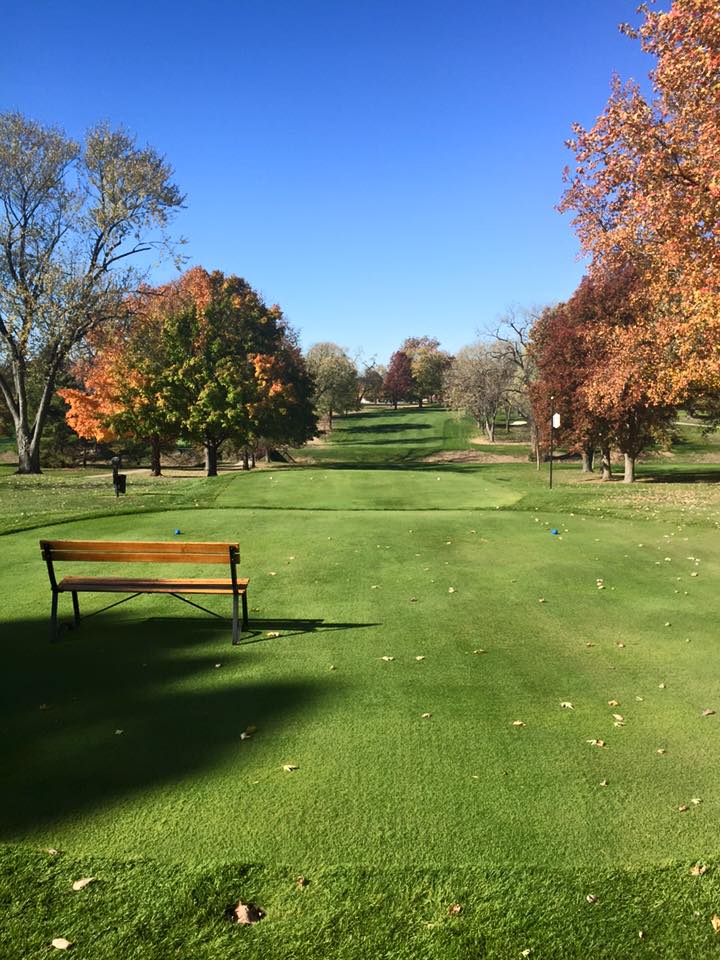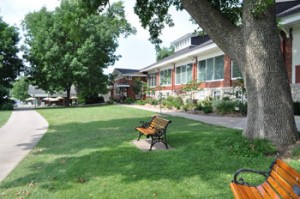History of Quincy Country Club
A Brief History 1898-1998
As early as 1897 there was an interest in golf in Quincy. During 1898 the Rev. Samuel H. Dana, pastor of the First Union Congregational Church from 1883-1903, was traveling in the East and observed people in New York playing the game for the first time in the United States.
Dr. Dana brought the game home to Quincy with a few clubs and golf balls. He and Morton Stewart laid out a course in a cow pasture just east of Lawndale, which is the neighborhood encompassing East and West Avenues. Tin cans were sunk into the ground to be used for holes. Others involved were Boyd Castle, Douglas Carter, Edward Wells, Alfred Botsford, T.E. Musselman and V.G. Musselman.
Later in 1898 Dr. Dana interested a large number of Quincy men in golf. They incorporated the Quincy Country Club on October 26, 1898, for the purpose of the social enjoyment of its members and for the promotion of golf and other sports. They selected the following men as directors: Charles H. Williamson, President; Joseph W. Emery, Vice President; Fred H. Wilms, Jr., Secretary; Edward J. Parker, Treasurer; Charles H. Bull, J.W. Cassidy, John A. Stillwell, W.P. Upham, and S.B. Montgomery. Others active in the organization were Frank Whitney, E.M. Botsford, William Stahl and Charles Nichols.
The Club began operation on a leased tract of land known as the “Forty Acres”, which was located south of the present Clubhouse and east of 24th Street between Washington and Madison streets, primarily in the neighborhood developed later as Country Club Drive. The land, sometimes also referred to as the Emery-Ayers property, was leased from the Walter F. Emery family for an initial term of 30 years. The Forty Acres was augmented with 23 acres of land known as the Stark property, which was located to the east across Emery Creek to about the present site of the sixth tee. The first Clubhouse was opened on September 27, 1899, at what is now 24th and Washington streets and boasted locker rooms, a dance hall, kitchen and porches. The Club had a nine-hole golf course, bowling alleys and ping pong, and meals were served upon notifying the steward. Tennis courts were added later.

The original golf course was laid out by H.J. Tweedie in May 1899 and ran 2,844 yards with bogey at 47. (Bogey was a more common goal of even experienced players in the early days of golf when playing conditions were much harsher than those today.) Later it was changed to 3,089 yards with bogey at 42. The names, distances and bogey figures of the original holes were as follows:
| Outward Bound, 344, 5
High Ball, 266, 4 Bridge of Sighs, 309, 5 |
Punch Bowl, 309, 5
Westward Ho, 359, 6 Baby, 193, 4 |
Isle of Woe, 401, 7
Devil’s Ditch, 326, 5 Taps, 337, 6 |
When the Club was founded, it secured George S. Turpie, a Scotsman, as its first golf professional and club maker. The Club’s longest-serving pro was Charles F. Clarkson, 1915-1917 and 1924-1960. Others have been E. B. Hagerbaumer, Allan Wyman, Carl Wiborg, Robert Shields, John Marschall and Lynn Rosely, the Club’s pro since 1967.
In 1901, the Club was instrumental in forming the Central Illinois Country Club Association, which consists today of the following clubs:
- Bloomington Country Club
- Champaign Country Club
- Country Club of Decatur
- Country Club of Peoria
- Danville Country Club
- Illini Country Club
- Quincy Country Club
- Soangetaha Country Club of Galesburg
Membership in the Association has fluctuated since its inception. In 1905 the Danville Country Club had replaced the Jacksonville Country Club, a founding member. The Association disbanded after the 1928 tournament and was revived with six clubs in 1946. Danville and Soangetaha country clubs later rejoined, resulting in the present membership.
Membership in the Association provides the members of each club the privileges of all other member clubs. Annually, the Association holds both women’s and men’s golf tournaments. The opportunity to host the tournaments rotates from club to club, year to year, thus allowing the members of the different clubs the opportunity to enjoy the facilities of the other clubs and meet their members.
In April 1918 the Club purchased 75 additional acres of Emery property at 24th and State streets extending along State Street to 30th Street. On August 15, 1919, the original Clubhouse burned to the ground and was replaced with the present Clubhouse which was opened on April 30, 1921. In 1920-1921 the course was expanded to 18 holes, par for which would have been 71. The early record for this new course was held by Charles L. “Chink” Weems (later a mayor of Quincy) with a 73 in the spring of 1922. Also, the Club bought the area that consists of today’s No. 10 from the Penington family sometime before 1925. Another major acquisition was the purchase of a portion of Belt’s Woods, which contained an orchard and was owned by John Belt. The land became today’s No. 4 and portions of Nos. 13 and 15. The Club abandoned the Forty Acres sometime during the period of these various changes.
The course was redesigned in 1927-1928 to approximately today’s configuration by a Chicago architect named Macomber, whose plans were implemented by Clarkson and incorporated elements of a design prepared but not fully implemented in 1925. The 12th fairway and green of the present course are the only ones that have been in constant use since 1898. They cover the eastern two-thirds of a par five of the original course that was known as the “Punch Bowl” because of the shape of its green.
Since the course was reconfigured, there have been a few other changes in the course. Bent grass greens were introduced by Clarkson beginning in 1924 first on No. 17 and then throughout the course. The fairways were converted to bent grass in the late 1980s. Location of the swimming pool in 1936 caused shifting of the ninth green slightly north to its present location and the 18th green from its spot in front of the Clubhouse (today’s putting and chipping green) to its present location by the tennis courts. Old No. 10 was converted to today’s practice range in the mid 1960’s, and Nos. 11 and 12 were redesignated Nos. 10 and 11. A new short par three was established as No. 13 in the formerly unused southeast corner of the Club property to accommodate these changes. In 1970-71 a lake was created in the southwest corner of the Club’s property, between Emery Creek and No. 11, in connection with the installation of an irrigation system. The present Club property includes approximately 130 acres of ground.
The Clubhouse has also expanded since its construction. In 1962-1963 the Carnoustie room was added to the south of the Clubhouse, replacing a dining room in the basement that occupied today’s business offices and a portion of the men’s locker room. Also, the porch was enclosed to create the Garden Room and the Ballroom was remodeled. The bar and lounge were constructed in 1995 to provide a place for informal dining and socializing for men and women. A new pro shop was opened in the spring of 1998.
 The Club has been unusually fortunate in the large percentage of championships it has won both in team play and individual play in golf. The outstanding Quincy golfer of the Club’s early days was Fred. H. Wilms, Jr., who won the first CICCA tournament in 1901 at Decatur. He was also Club champion in 1899, 1900, 1902, 1903, and 1906. Other Quincy champions of the CICCA men’s tournament have been as follows: Dr. W. H. Baker, 1905; George J. McMein, 1906; Will Sinnock, 1908, 1913; Charles L. Weems, 1916, 1922, 1927; Allen M. Oakley, 1925; Lawrence F. Moller, 1928, 1950, 1951, 1953, 1957, 1959, 1960; Dennis K. Cashman, 1967; Mike O’Connell, 1980, 1982, 1986; and Richard A. Pruitt, 1983, 1996.
The Club has been unusually fortunate in the large percentage of championships it has won both in team play and individual play in golf. The outstanding Quincy golfer of the Club’s early days was Fred. H. Wilms, Jr., who won the first CICCA tournament in 1901 at Decatur. He was also Club champion in 1899, 1900, 1902, 1903, and 1906. Other Quincy champions of the CICCA men’s tournament have been as follows: Dr. W. H. Baker, 1905; George J. McMein, 1906; Will Sinnock, 1908, 1913; Charles L. Weems, 1916, 1922, 1927; Allen M. Oakley, 1925; Lawrence F. Moller, 1928, 1950, 1951, 1953, 1957, 1959, 1960; Dennis K. Cashman, 1967; Mike O’Connell, 1980, 1982, 1986; and Richard A. Pruitt, 1983, 1996.
The Club has hosted many of golf’s greatest players. One of the first was Charles “Chick” Evans who in 1923 spent a weekend at QCC playing two 18-hole rounds with various Club members. Evans was the first to win the U.S. Open and the U.S. Amateur in the same year (1916). Also, he won the Western Amateur eight times. Many other greats have visited Quincy, particularly those who have joined D.A. Weibring at the D.A. Weibring ARC Charity Golf Event. They include such players as Sam Snead, Byron Nelson, Gene Sarazen, Gay Brewer, Fred Couples, Jay Haas, Hale Irwin, Peter Jacobsen, Tom Kite, Tom Lehman, Justin Leonard, Davis Love, Mark O’Meara, Payne Stewart, Curtis Strange, Tom Watson and Fuzzy Zoeller.
Many great golfers including some golf professionals have started their golfing careers at the Club. Among them was Edwin H. “Eddie” Williams who was one of the Club’s better players in the years immediately after World War I.
Among the second generation of Club golfers, the greatest have been the late Larry Moller and Allen Oakley. Either Moller or Oakley has played at the Club in every decade from and including the 1920s, and both men played with some of the Club’s first generation of golfers, including Fred Wilms who died in 1934. Moller won seven CICCA tournaments, more than any other player in the tournament’s history, and at least 13 Club championships. Oakley has won five Club championships and is the oldest surviving CICCA champion, having won the tournament in 1925 at the age of 17 in his first of many appearances. Also, research indicates Oakley continues to hold the record golf score for the course at 63. More recently, Lynn Rosely and Derek Dicks have matched that feat. For many Club members, the names Larry Moller and Allen Oakley have become synonymous with golf.
Many women have figured prominently in the Club’s golf history. Katherine Botsford Gay retired the first women’s club championship trophy in 1924 after wins in 1920, 1922, and 1924. Other notable women golfers in the Club’s history have been Florence Halbach Williams, Ella A. Rogers, Ella B. Barber, Ruth Tenk and, more recently, Betty Ann Robinson who has won 23 Club championships.
The Club has also played a role in organizing state and city tournaments and has hosted national golf events. In 1924 Clarkson organized the first City Open Championship at the Club, which many members of the Club have won throughout the years. The Club joined the Chicago Golf Association in 1931 to hold in Quincy the first-ever Illinois State Amateur Championship, and the Club has been the site of the Illinois Women’s State Amateur Championship several times. In 1971 the Club hosted the PGA Tournament Players Division Regional Qualifying School for the Midwest region.

